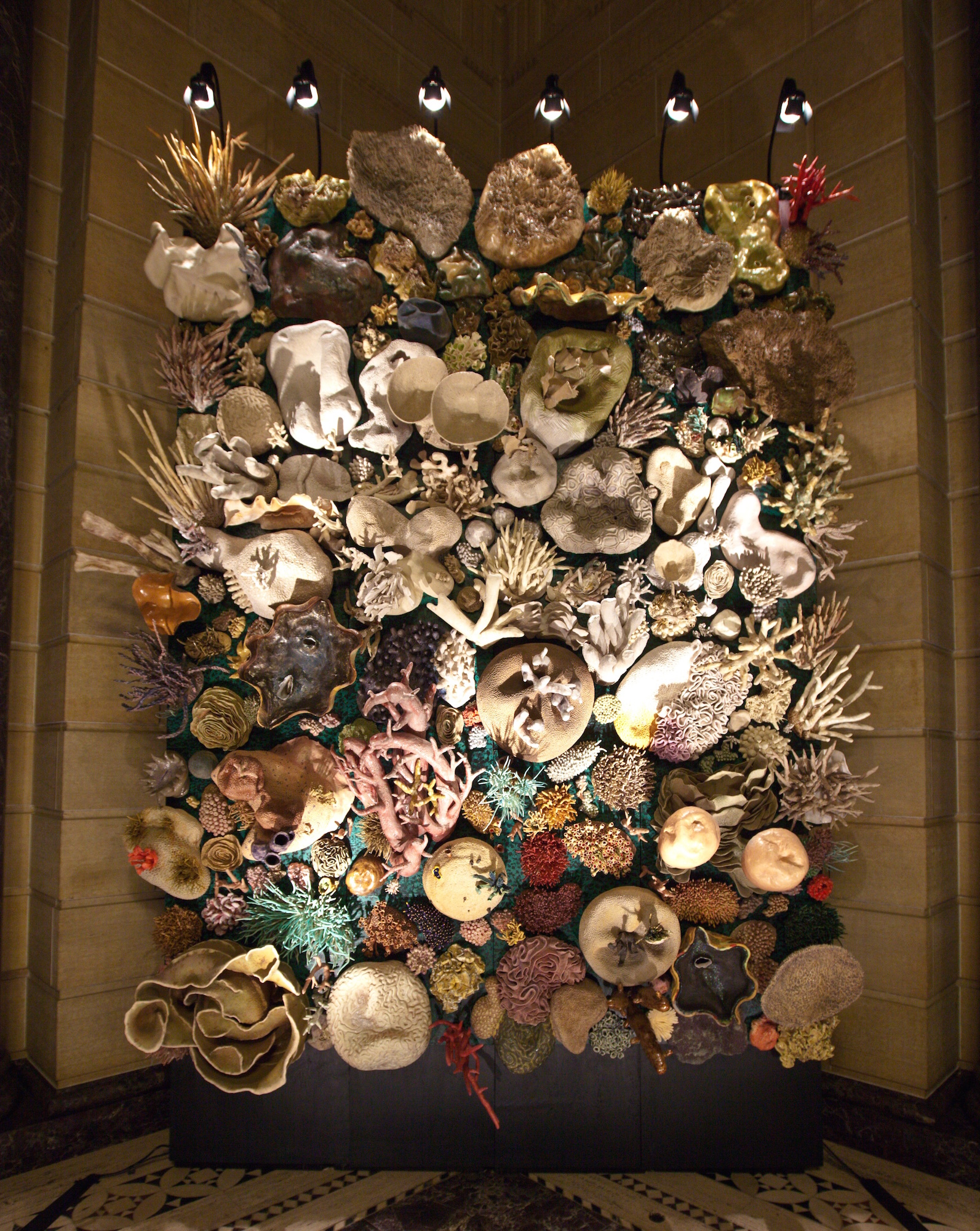









a coral reef story
by courtney mattison
2010-2011
glazed stoneware + porcelain + terra cotta; plywood
455 x 270 x 100 cm (179 x 106 x 39 in)
on public display weekdays 9 am – 5 pm
aaas art of science & technology gallery
american association for the advancement of science (aaas)
nw corner of 12th st nw & h st nw, washington, d.c. 20005
Our Changing Seas I: A coral reef story is a creative outreach project that aims to inspire coral reef stewardship and policy change. It is the culmination of a master’s thesis by Courtney Mattison at Brown University’s Center for Environmental Studies with coursework at the Rhode Island School of Design (RISD).
This gallery accompanies the exhibition of a large-scale ceramic coral reef wall installation that debuted in the lobby of the Herbert C. Hoover Building in Washington, DC in April 2011, and was hosted by NOAA and the US Department of Commerce.
This work is currently on loan with the American Association for the Advancement of Science (AAAS) and is on display in the lobby of AAAS Headquarters.
The design of this work is informed by interviews Mattison conducted with marine researchers, artists, and marine environmental professionals.
Artist Statement:
The exquisite diversity and complexity of coral reef organisms provide myriad opportunities for scientific discovery and artistic inspiration. I am a visual learner, and first began sculpting marine invertebrates to better understand their anatomy and ecology. As my skills developed and my studies led me into fieldwork on the Great Barrier Reef, I began to appreciate both the threats to coral reefs and the ability of art to evoke emotional connections to them. Perhaps if my work can influence others to appreciate the fragile beauty of our endangered coral reef ecosystems, we will act more wholeheartedly to conserve them.
Scleractinian corals – also known as “hard” or “stony” corals – are responsible for laying the foundation of a coral reef. These colonial animals are able to precipitate calcium carbonate from seawater to form rigid skeletons that, over time, build off of one another to compose the vast, complex structures we know as reefs. In fact, corals are so proficient at this chemical process that those within the Great Barrier Reef have earned the title of the world’s “largest living thing.” It therefore feels essential that the medium of my work be ceramic, as calcium carbonate also happens to be a common ingredient in clay and glaze materials. Not only does the chemical structure of my work parallel that of a natural reef, but brittle ceramic anemone tentacles and coral branches break easily if improperly handled, similar to the delicate bodies of living reef organisms.
This large-scale ceramic coral reef wall installation is based on my interdisciplinary study of how art can inspire marine conservation. This project combines reef conservation science and policy, fine art, and social sciences. I interviewed marine researchers, artists inspired by nature, and marine professionals regarding their thoughts on how art can promote coral reef stewardship and policy change. Selected quotes from these interviews are displayed on either side of the piece to illustrate these experts’ voices uniting to emphasize the critical importance of coral reef conservation to policy makers and the public.
Prominent concepts that arose from my interviews – particularly those regarding human interactions with reefs – informed the design of this installation. The marine researchers, artists, and marine professionals who I spoke with emphasized the importance of drawing viewers' attention to our relationship with reefs, their fragile beauty, and the threats we impose on them. Our carbon dioxide emissions, overfishing, and land-based sources of nutrient pollution affect the delicate balance of chemical and ecological factors that allows reefs to function. This installation represents the transition from a healthy, diverse, vibrant reef ecosystem at eye level up into a degraded reef suffering from coral bleaching due to climate change and finally algal-domination resulting from overfishing and nutrient pollution. The upper righthand corner depicts a bright red coral branching out from the green algal slime as a sign of hope that with enough public and political action to decrease our cumulative impacts, we can still help coral reefs recover and even thrive.
Photos by Derek Parks for NOAA *